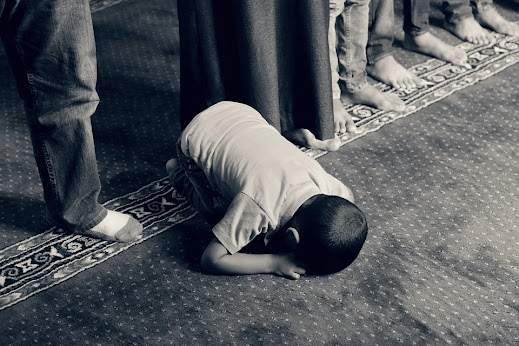How to Perform Eid ul Fitr Namaz
 |
| Method of Eid prayer |
What is Eid ul Fitr
Eid al-Fitr marks the finish of Ramadan, the Muslim sacred month of fasting, and is praised during the initial three days of Shawwal, the tenth month of the Islamic schedule (however the Muslim utilization of a lunar schedule implies that it might fall in any period of the year)
.Section into paradise becomes Wājib
Sayyidunā Mu'āż Bin Jabal رَضِىَ اللهُ تَعَالٰی عَنْهُ has portrayed that the Holy Prophet صَلَّى اللهُ تَعَالٰى عَلَيْهِ وَاٰلِهٖ وَسَلَّم said,
'One who stays conscious (performing love) in the accompanying five evenings, Heaven becomes Wājib for him: the evenings of the eighth, ninth and tenth Żul-Ḥijjaĥ, the evening of Eid-ul-Fiṭr and the fifteenth evening of Sha'bān (Shab-e-Barā'at).
(Attarghīb Wattarĥīb, vol. 2, pp. 98, Ḥadīš 2)
A Sunnaĥ before Eid Ṣalāh
Sayyidunā Buraydaĥ رَضِىَ اللهُ تَعَالٰی عَنْهُ has expressed, 'upon the arrival of Eid-ul-Fiṭr, the Holy Prophet صَلَّى اللهُ تَعَالٰى عَلَيْهِ وَاٰلِهٖ وَسَلَّم would go to offer Eid Ṣalāĥ in the wake of eating something, though on Eid-ul-Aḍḥā, he صَلَّى اللهُ تَعَالٰى عَلَيْهِ وَاٰلِهٖ وَسَلَّم would not eat anything except if he صَلَّى اللهُ تَعَالٰى عَلَيْهِ وَاٰلِهٖ وَسَلَّم offered Eid-Ṣalāĥ.'
(Jāmi' Tirmiżī, vol. 2, pp. 70, Ḥadīš 542)
Similarly, in Bukhārī, there is another Ḥadīš described by Sayyidunā Anas رَضِىَ الـلّٰـهُ تَـعَالٰی عَـنْهُ, 'upon the arrival of Eid-ul-Fiṭr, the Beloved and Blessed Prophet صَلَّى اللهُ تَعَالٰى عَلَيْهِ وَاٰلِهٖ وَسَلَّم would not go until he صَلَّى اللهُ تَعَالٰى عَلَيْهِ وَاٰلِهٖ وَسَلَّم ate a couple of dates in odd numbers.'
(Ṣaḥīḥ Bukhārī, vol. 1, pp. 328, Ḥadīš 953)
Sunnah of Eid ul Fitr
1 To rise early in the first part of the day.
How to offer Eid ul Fitr Namaz
First make the accompanying aim: 'I mean to offer two Rak'āt Ṣalāĥ of Eid-ul-Fiṭr (or Eid-ul-Aḍḥā) with six extra Takbīrāt, for Allah عَزَّوَجَلَّ, following this Imām.'
Having made the expectation, lift the hands up to the ears, utter اَللّٰهُ اَكۡبَر and afterward overlay the hands beneath the navel and recount the Šanā. At that point lift your hands to your ears, utter اَللّٰهُ اَكۡبَر and leave them along the edges; at that point lift the hands to the ears once more, utter اَللّٰهُ اَكۡبَر and leave them along the edges; at that point lift the hands to the ears by and by, utter اَللّٰهُ اَكۡبَر and overlap them. To put it plainly, the hands will be collapsed after the first and fourth Takbīr, while they will be left along the edges after the second and third Takbīr. All in all, the hands will be collapsed when something is to be presented in Qiyām after Takbīr, while they will be left along the edges when nothing is to be recounted. At that point, the Imām will recount Ta'awwuż and Tasmiyaĥ in a soft tone, and Sūraĥ Al-Fātiḥaĥ and another Sūraĥ so anyone might hear. From that point, he will perform Rukū'. In the second Rakat, the Imām will initially discuss Sūraĥ Al-Fātiḥaĥ and another Sūraĥ out loud.
(Gotten from Durr-e-Mukhtār, Rad-dul-Muḥtār, vol. 3, pp. 66)
After the recitation, utter three Takbīrāt lifting the hands to the ears each time and leaving them along the edges. At that point, perform Rukū’ by uttering the fourth Takbīr without raising the hands, and complete the rest of the Ṣalāĥ as per the usual method. To stand silent between every two Takbīrāt for as long as سُبۡحٰنَ اللّٰه can be uttered thrice is necessary.’ (Baĥār-e-Sharī’at, vol. 1, pp. 781; Durr-e-Mukhtār, vol. 3, pp. 60)
For whom Eid Ṣalāĥ is Wājib?
The Ṣalāĥ of both Eids (for example Eid-ul-Fiṭr and Eid-ul-Aḍḥā) is Wājib, however just for those individuals whom Ṣalāt-ul-Jumu'aĥ is Wājib for. Besides, neither Ażān nor Iqāmat is expressed for the Ṣalāĥ of both Eids.
(Baĥār-e-Sharī'at, vol. 1, pp. 779; Durr-e-Mukhtār, vol. 3, pp. 51)




Mashallah
ReplyDelete❤️
Delete❤️
ReplyDelete😍mashallah
ReplyDelete❤️
Delete